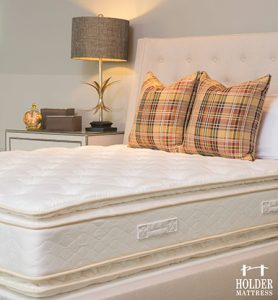You’ve got to love marketing! I’m sure there is a large group of people, “thinkers,” stuck in a conference room somewhere in a big city just racking their brains over the next great gimmick, tag line or cute mascot… They are trying to figure out how to get you, the consumer, to let go of your hard earned money and hand it over to their client. When you are a mattress manufacturer or retailer, you know at least two things; one, every one needs a mattress and two, the average consumer doesn’t know when to buy a new one.
I always tell my customers that it often takes a stay at a hotel to show you how uncomfortable you are at home. Sometimes it takes a complete collapse of your bed to reevaluate your mattress. I have watched countless couples struggle to determine the age of their current mattress. It usually starts with, “well, Amy is in college now and we got that mattress when she was….” or, “it was a gift from Uncle Grant for our wedding and I think it was his guest room mattress so it’s probably….” or my favorite, “it was only 1990, so it isn’t that old…” That is when I usually point out that 1990 was over 30 years ago!
The question is, how long does a mattress last? The answer is not so simple…
It all depends. It depends on the quality of the product you purchase. It depends upon the amount of cushion in the product. It depends upon the intended use of the product.
The quality of the product has everything to do with the longevity of the product. A starting point set does not typically last as long as a top of line set. That is not a steadfast rule, but it applies more often than not. If the product comes with a coil box spring as opposed to a foundation, it has a better support system and will wear much better. If a product is two sided and can be flipped and rotated it will last at least twice as long as a one-sided product that cannot be flipped. If the product is made from high density foams intended to be more durable, the mattress will be more durable. I could go on and on. The initial quality helps determine how long a mattress will last. This is partly why many people believe that mattresses in general just don’t last as long as they used to. It’s true partly because mass manufacturers do not use the same high-quality materials that they once did. Raw material vendors don’t offer the same quality in some cases because many manufacturers are buying lesser quality materials to cut costs. The quality of the springs, foam and fiber all contribute to the overall quality of the product and therefore, how long that product can last.
There is one exception to the “quality debate.” Cushion. The more cushion, I.e. foam and fiber, in a product, the more the consumer will notice aging in the product. When a mattress begins to age, the first material to break down is the fiber, second is the foam. These materials make up the cushion and thus the “feel” of the mattress. If you have lots of cushion, a box top or Euro top or pillow top, you will have more foam and fiber to break down. Your mattress feel will change more significantly than say, a firm top, or a mattress that had very little foam and fiber from the start. That is not to say that a firm mattress does not age at the same rate as a soft mattress, only that aging is more noticeable in the soft mattress. This gives the consumer the impression that a firm mattress lasts longer. In truth, it feels “like new” longer than a mattress that has lots of cushion. The real issue here is different. A firm mattress may seem to last longer, but if you aren’t comfortable on the mattress, do you really want it to last? Comfort is still the key!
Finally, the intended use of the product helps determine its durability. A master bedroom set that is used nightly by an adult couple will not last as long as a guest room mattress that is used only sparingly. A child’s mattress may last much longer as the child weighs less, or may not last as long, if the child does not care for the mattress. (Mattresses are not trampolines. We do not recommend using them as so. If your child wishes to jump, buy him a trampoline. Mattresses are not designed to hold up to jumping children.) When a person comes in to buy a new mattress, we always ask about the intended use of the product. This information helps us help you. If you are looking for a guest room, I will typically show you different sets than if you are looking for a master bedroom set. The more use a mattress gets, the more it wears. That is not to say that your guest room mattress should never be replaced. Nothing lasts forever. Unless you really don’t want your guests to come back, make sure to replace the guest room set once or twice, too… maybe just not as often as the other sets in your home.
So when considering all of the factors, keep in mind that every situation is different. We, unlike another mattress company out there, do not recommend replacing your mattress every eight years. And by the way, you cannot determine the age of the mattress simply by lifting it. Nor will your mattress double in weight after eight years, unless you aren’t fond of mattress protectors and general cleanliness. (Protecting your mattress and regularly washing the protector and other bedding will eliminate excess dust mites, skin flakes and other body fluids that contribute to your mattress gaining weight.) We do recommend reevaluating your set after ten years. Simply ask yourself if your mattress still meets your needs. If it does, keep it. If it doesn’t, start searching for a set that does. Sometimes mattresses stop meeting our needs after only a short while. Great changes in your body, surgeries, pregnancy, shift changes, schedules, etc… can affect your sleep. When your mattress no longer meets your needs, that is when you need to replace it.



